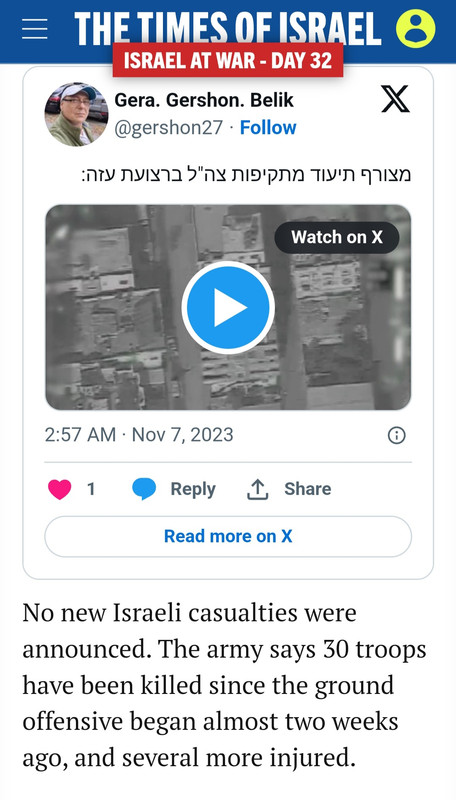大量加沙城居民举着白旗和双手通过以军指定的人道走廊撤离,以军已到达加沙市中心,并占领医院附近的哈马斯军事据点
版主: Softfist
#8 Re: 加沙城居民举着白旗和双手通过以军指定的人道走廊撤离,以军已到达加沙市中心,并占领医院附近的哈马斯军事据点
费卢杰美军3分钟就占领了市中心
If printing money would end poverty, printing diplomas would end stupidity.
#11 Re: 加沙城居民举着白旗和双手通过以军指定的人道走廊撤离,以军已到达加沙市中心,并占领医院附近的哈马斯军事据点
直升机机绛部队。当年费卢杰叛军装备比加沙哈马斯还简陋,完全没有任何防空武器
If printing money would end poverty, printing diplomas would end stupidity.
#15 Re: 加沙城居民举着白旗和双手通过以军指定的人道走廊撤离,以军已到达加沙市中心,并占领医院附近的哈马斯军事据点
扯淡,自己读
https://en.wikipedia.org/wiki/Second_Battle_of_Fallujah
11/7开始外围炮击,火力扫荡了2天以后,11/9夜里海军陆战队的机绛部队就占领了市中心
https://en.wikipedia.org/wiki/Second_Battle_of_Fallujah
11/7开始外围炮击,火力扫荡了2天以后,11/9夜里海军陆战队的机绛部队就占领了市中心
lgw 写了: 2023年 11月 7日 10:03 张嘴就来,美军第一次攻占费卢杰也是地面进去的,第二次花了一周。美帝就没用直升机攻占目标城市的习惯,那是你俄爹的奇怪习惯,可能是因为俄罗斯总是去打自己小兄弟的关系。
美军第一次攻占费卢杰,也是一年以后才开始袭击美军的。
If printing money would end poverty, printing diplomas would end stupidity.
#17 Re: 加沙城居民举着白旗和双手通过以军指定的人道走廊撤离,以军已到达加沙市中心,并占领医院附近的哈马斯军事据点
赖美豪中 写了: 2023年 11月 7日 10:11 扯淡,自己读
https://en.wikipedia.org/wiki/Second_Battle_of_Fallujah
11/7开始外围炮击,火力扫荡了2天以后,11/9夜里海军陆战队的机绛部队就占领了市中心
下面这话是你说的吧?
另外麻烦你指出来下面哪句话说机降了?
With Navy SEAL and Marine Recon Snipers providing reconnaissance and target marking on the city perimeter, ground operations began on the night of 7 November 2004. Attacking from the west and south, the Iraqi 36th Commando Battalion with their U.S. Army Special Forces advisers, 1st and 2nd Platoon Charlie Company, Manchu 1st Battalion 9th Infantry Regiment Mechanized, 2nd Brigade Combat Team, 2nd Infantry Division (U.S. Army) served as the main effort on the peninsula and supported by 3rd Platoon Alpha Company 2/72nd Tank Battalion (U.S. Army), and 3rd Light Armored Reconnaissance Battalion, reinforced by Bravo Company from the Marine Corps Reserve's 1st Battalion, 23rd Regiment, and supported by Combat Service Support Company 122.
2nd Infantry Division, Manchu, Charlie Co 1-9 Infantry Mechanized with 1st and 2nd platoons, (US Army) SEAL Sniper Task Elements from Naval Special Warfare Task Group Central and the U.S. Marine Corps Scout Platoons, captured Fallujah General Hospital, Blackwater Bridge, ING building, and villages opposite of the Euphrates River along Fallujah's western edge.[45] Marines from 1/3 fired 81mm mortars in an operation in south Fallujah. The same unit then moved to the western approaches to the city and secured the Jurf Kas Sukr Bridge.[45] These initial attacks, however, were a diversion intended to distract and confuse insurgents holding the city, preceding the all-out offensive. Two Marines died in the initial attacks when their bulldozer fell into the Euphrates River. 42 insurgents were killed along the Fallujah riverside.
After Navy Seabees from I MEF Engineer Group (MEG) and Army Civil Affairs soldiers interrupted and disabled electrical power at two substations located just northeast and northwest of the city, two Marine Regimental Combat Teams, Regimental Combat Team 1 (RCT-1) and Regimental Combat Team 7 (RCT-7) launched an attack along the northern edge of the city. They were joined by two U.S. Army heavy battalion mechanized units, the 2nd Battalion, 7th Cavalry Regiment, and Task Force 2nd Battalion, 2nd Infantry Regiment (Mechanized), followed by four Marine infantry battalions tasked with clearing buildings. The Army's mechanized Second Brigade, First Cavalry Division, Marines' 2nd Light Armored Reconnaissance Battalion and A. Co 1st Battalion, 5th Infantry Regiment, was tasked with infiltrating the city and destroying any fleeing enemy forces.[46] The British Army's 1st Battalion, The Black Watch, patrolled the main highways to the east. The RCTs were augmented by three 7-man SEAL Sniper Teams from Naval Special Warfare Task Group-Central and one platoon from 1st Recon, who provided advance reconnaissance in the city, Joint Terminal Aircraft Control (JTAC) and unilateral overwatch throughout the operation. The United States Air Force provided close air support for the ground offensive, employing F-15 Strike Eagles, F-16 Fighting Falcons, A-10 Thunderbolt IIs, B-52 Stratofortresses, and AC-130 gunships to carry out close-quarter precision airstrikes against enemy strongholds within the city. The Air Force also employed MQ-1 Predator unmanned aerial vehicles for reconnaissance and precision strikes, and the U-2 Dragon Lady high-altitude reconnaissance aircraft for intelligence collection, surveillance and reconnaissance before, during, and after the battle.
The six battalions of U.S. and Iraqi forces, aided by Marine Corps Scout and Target Acquisition, SEAL Sniper, and JTAC elements pre-fire operations, moved into the city under the cover of darkness; and once aligned with the reconnaissance elements, began the assault in the early hours of 8 November 2004, preceded by an intense artillery barrage firing some 2500 155mm projectiles and air attack. This was followed by an attack on the main train station, which was then used as a staging point for follow-on forces. By that afternoon, under the protection of intense air cover, Marines entered the Hay Naib al-Dubat and al-Naziza districts. The Marines were followed by the Navy Seabees of NMCB 4 and NMCB 23 who bulldozed the streets clear of debris from the bombardment that morning. The Seabees used armored bulldozers to plow the streets while remaining safe and protected from enemy fire. Shortly after nightfall on 9 November 2004, Marines had reportedly reached Phase Line Fran at Highway 10 in the center of the city.
While most of the fighting subsided by 13 November 2004, U.S. Marines and Special Operations Forces continued to face determined isolated resistance from insurgents hidden throughout the city. By 16 November 2004, after nine days of fighting, the Marine command described the action as mopping up pockets of resistance. Sporadic fighting continued until 23 December 2004.
By late January 2005, news reports indicated U.S. combat units were leaving the area, and were assisting the local population in returning to the now heavily damaged city.



